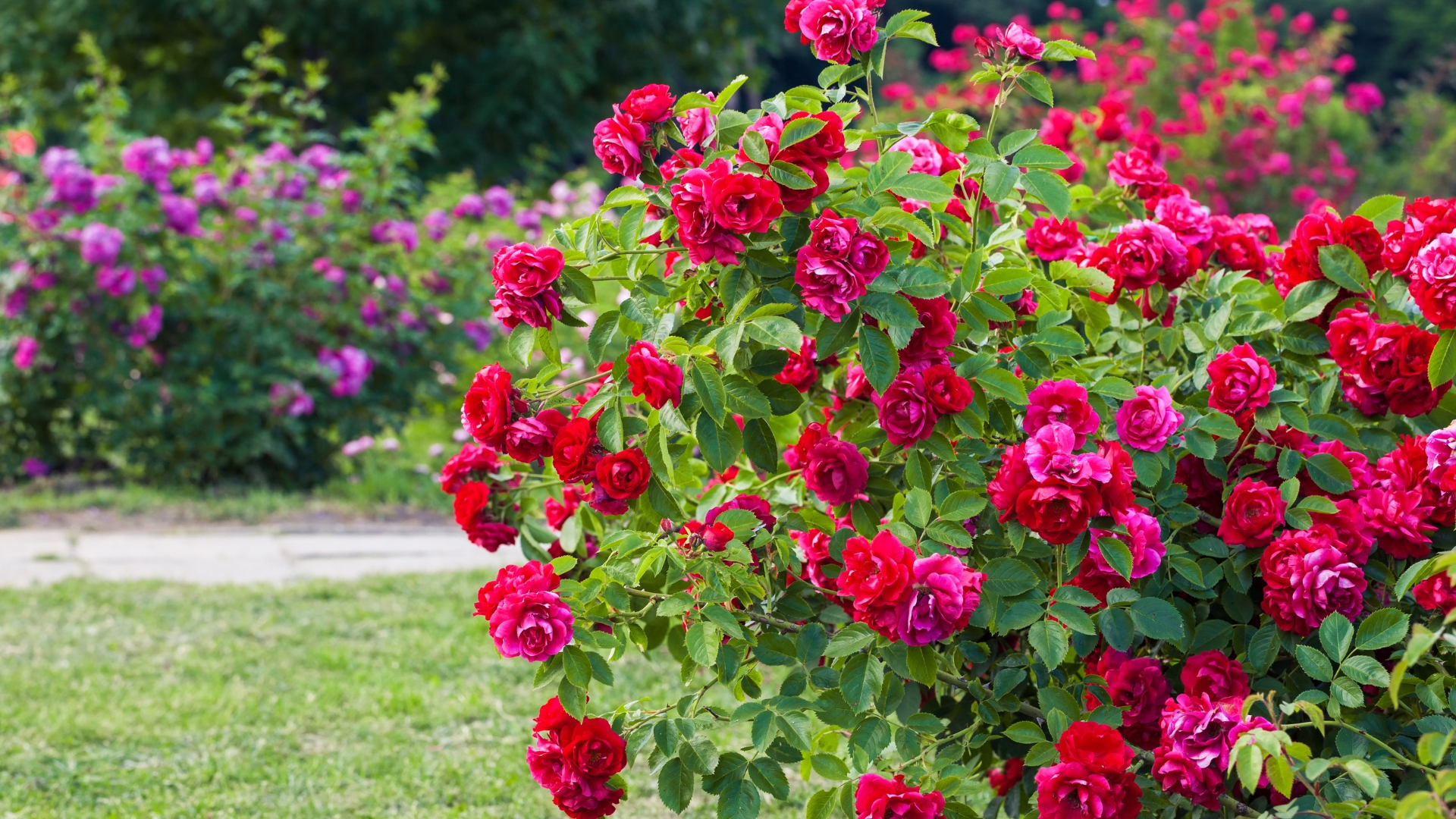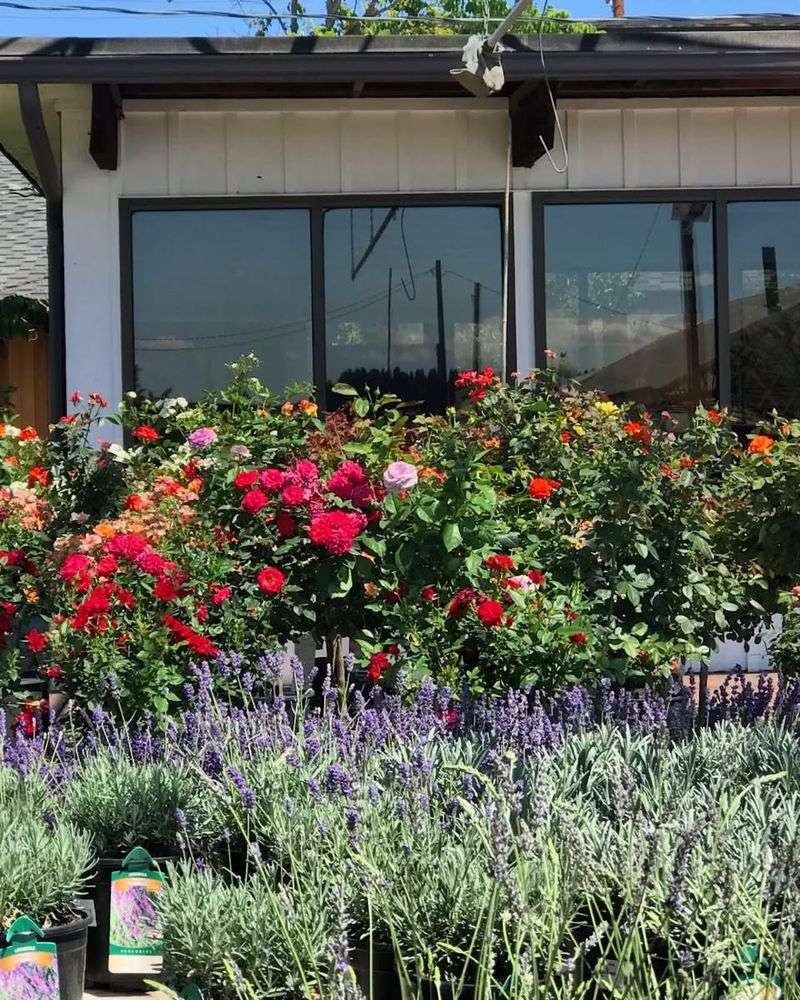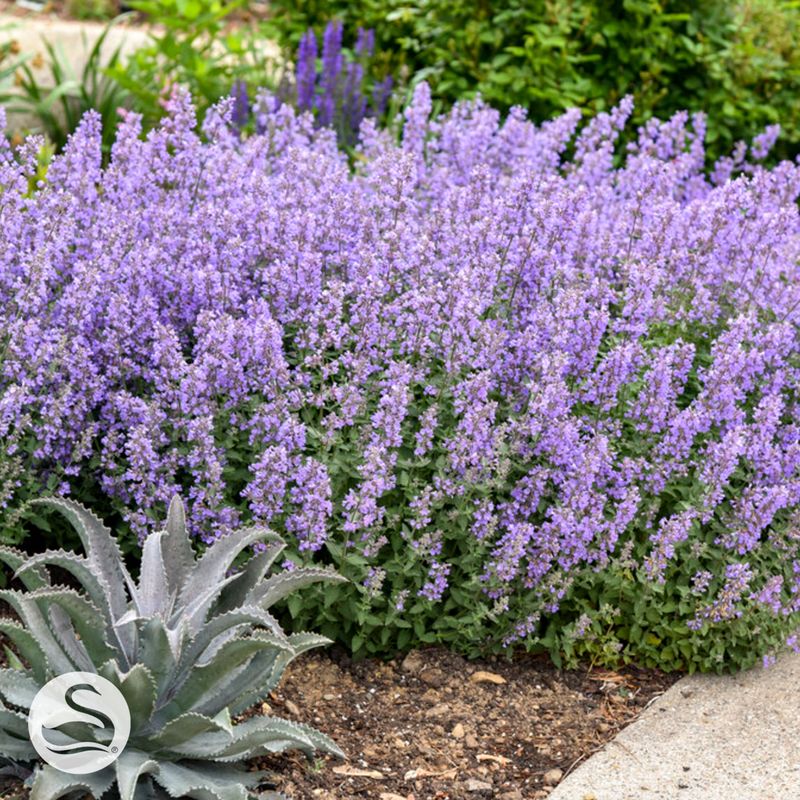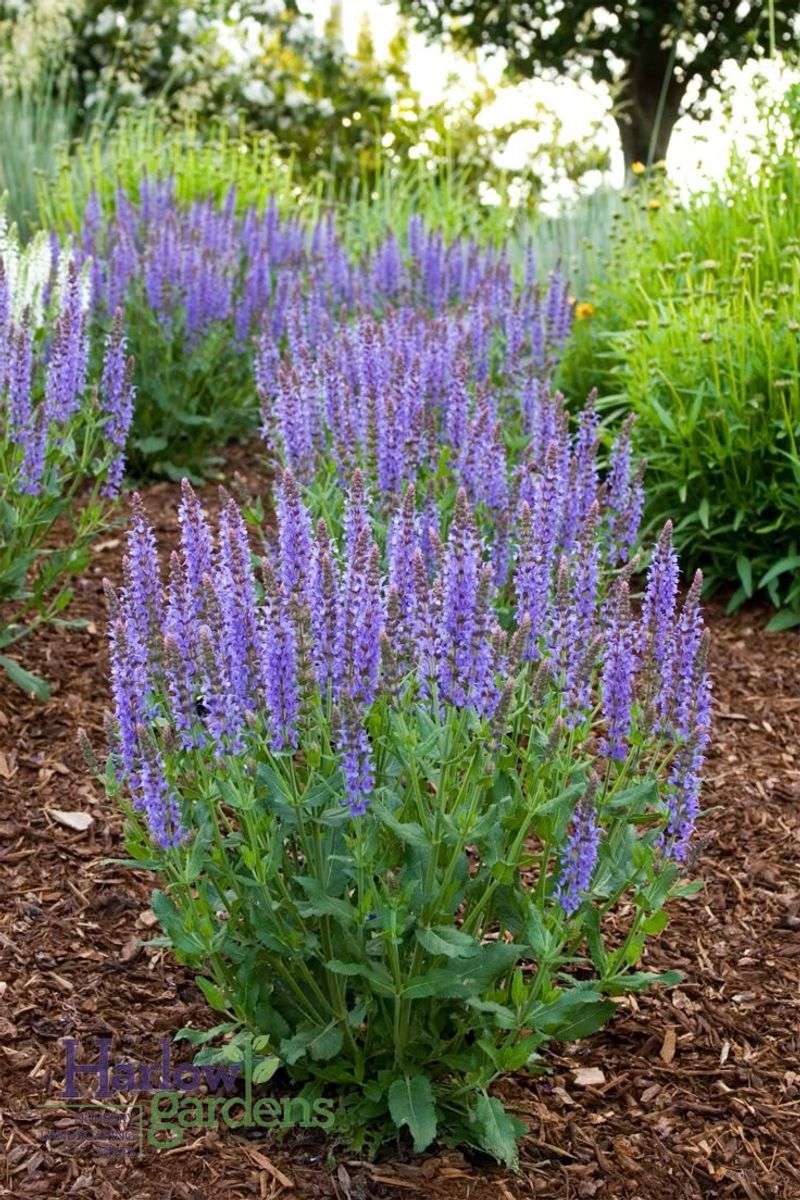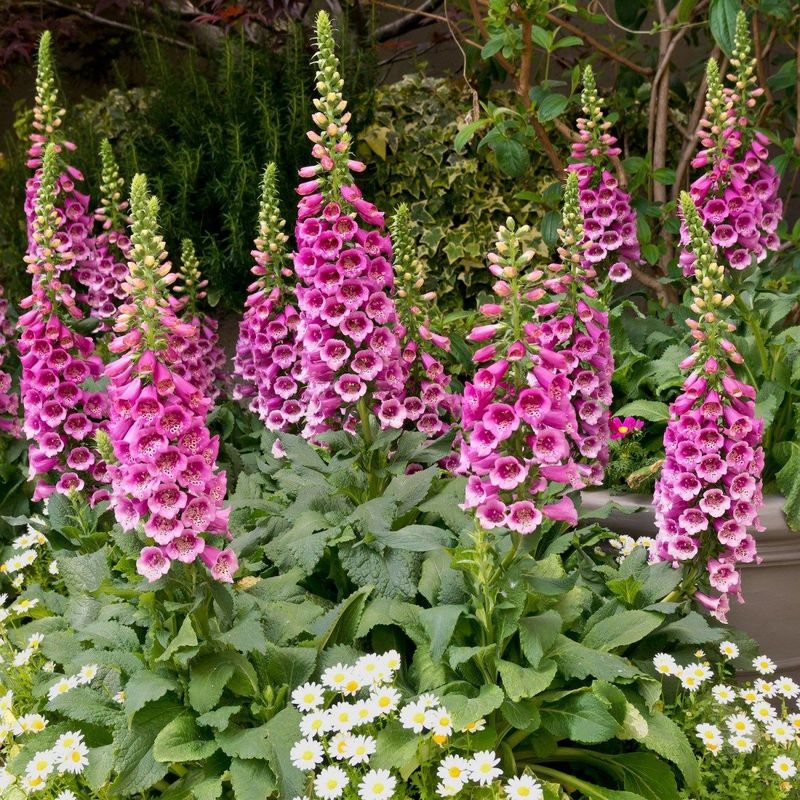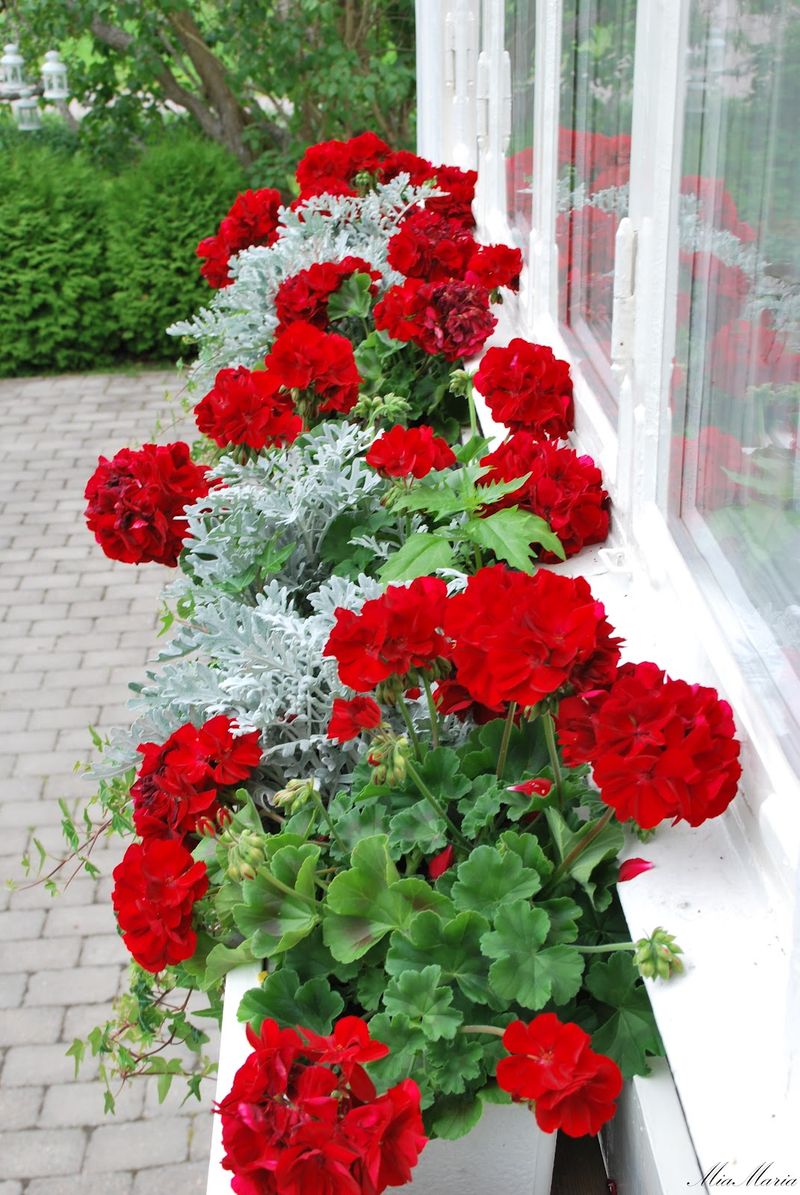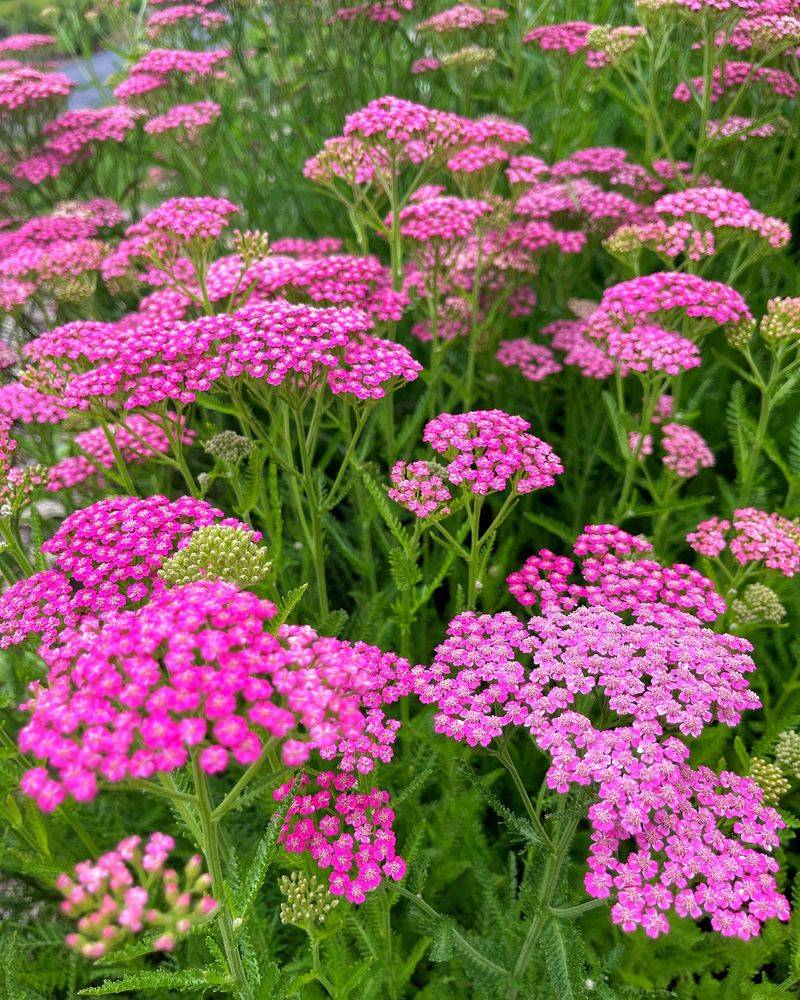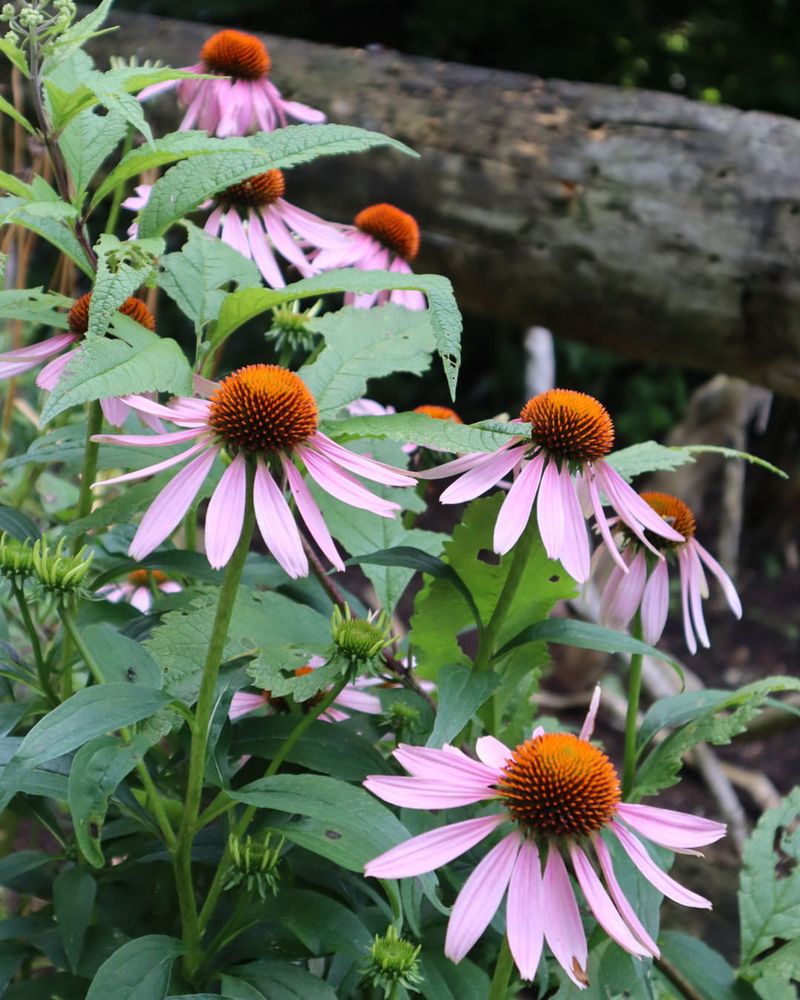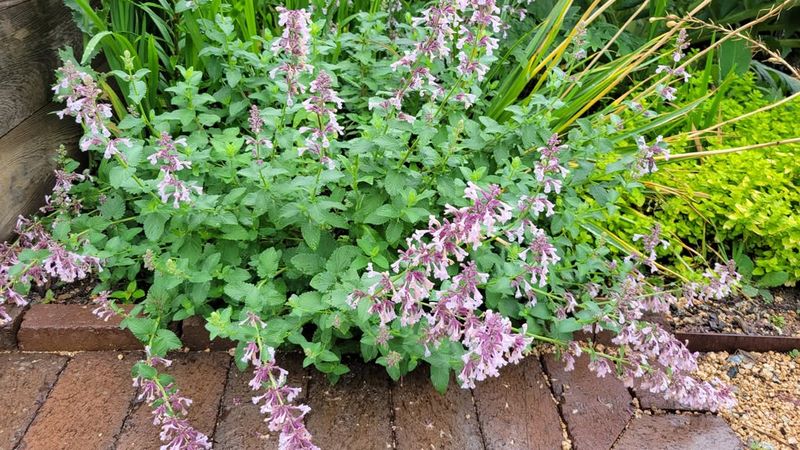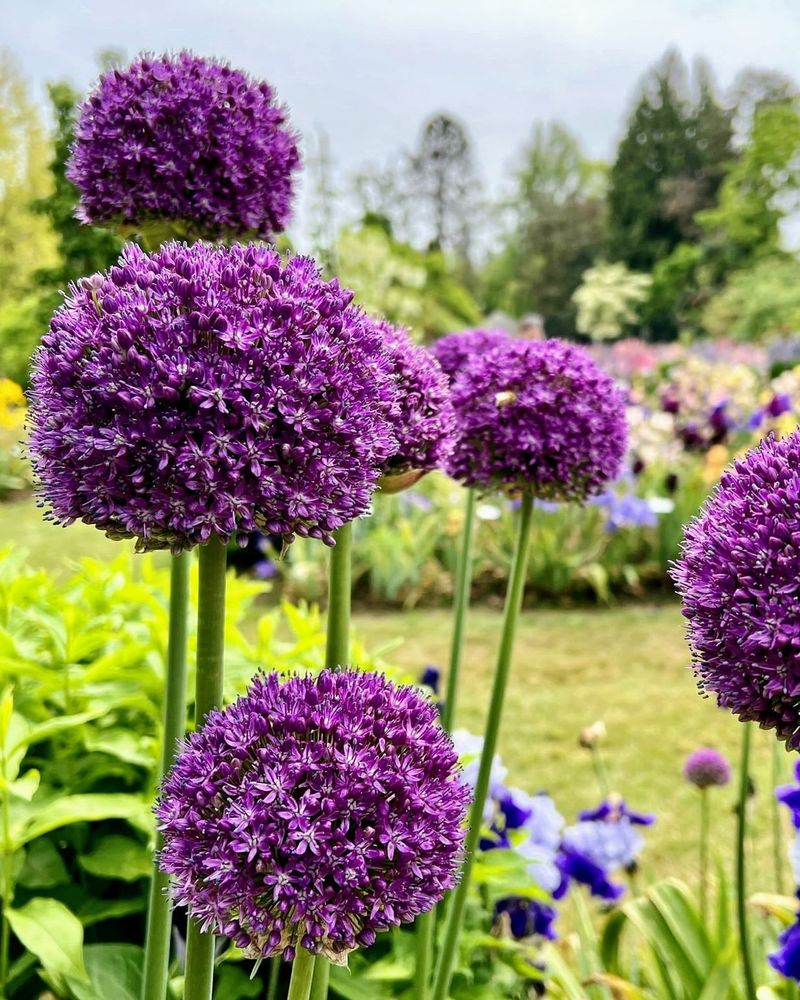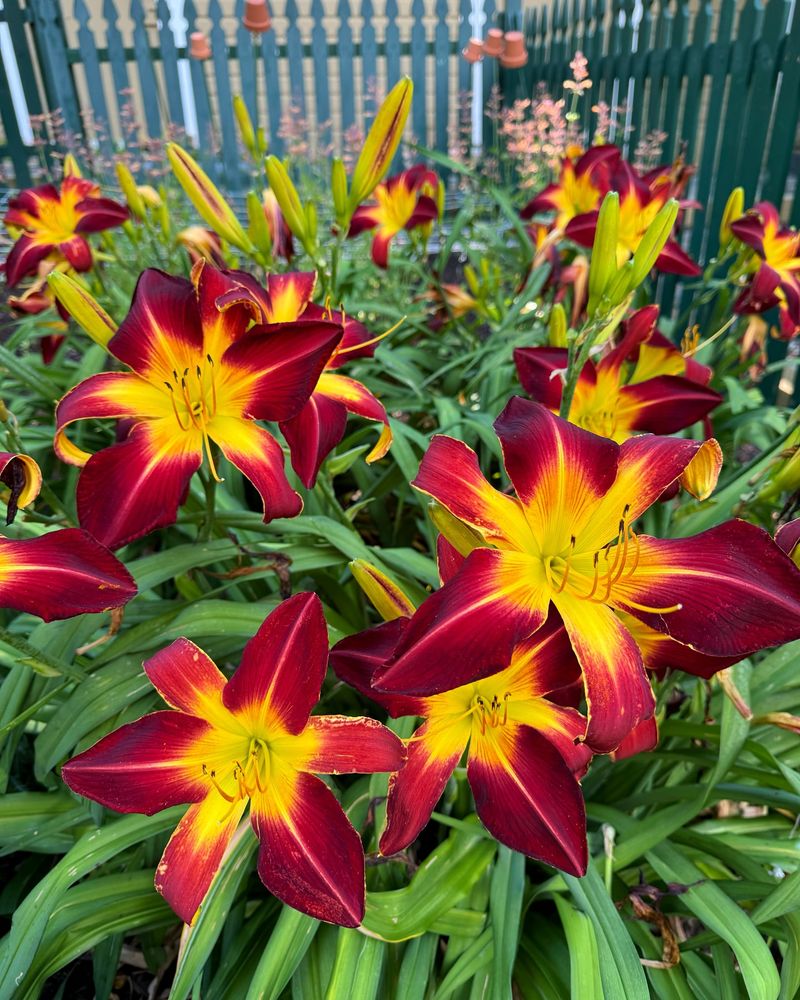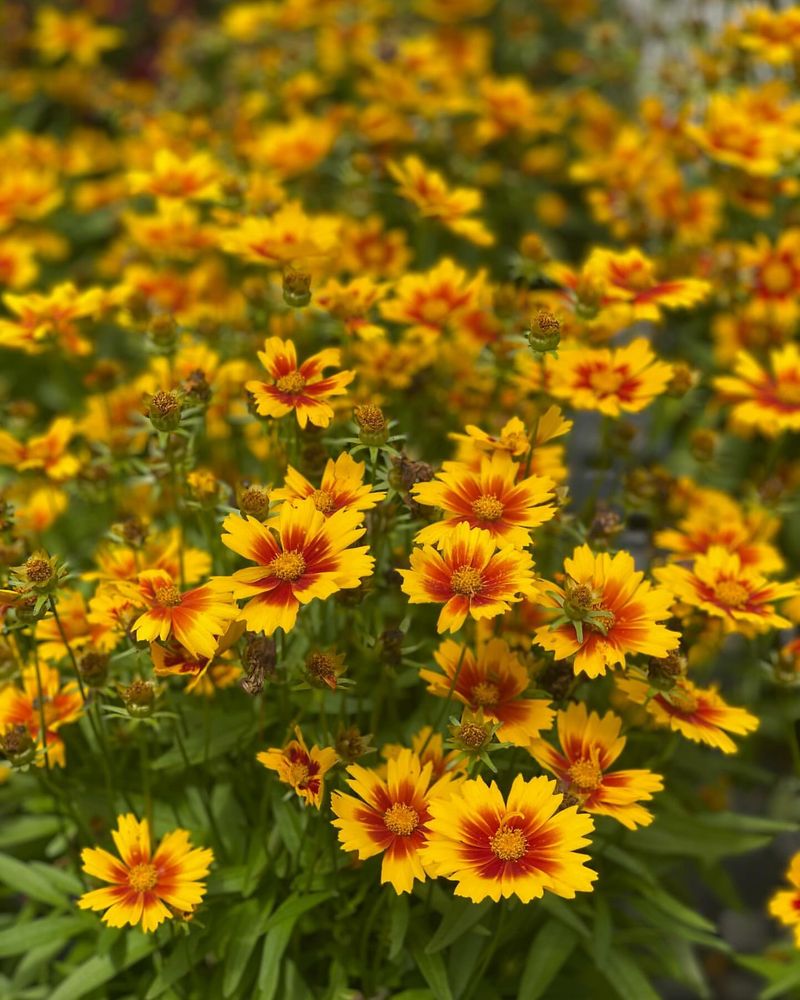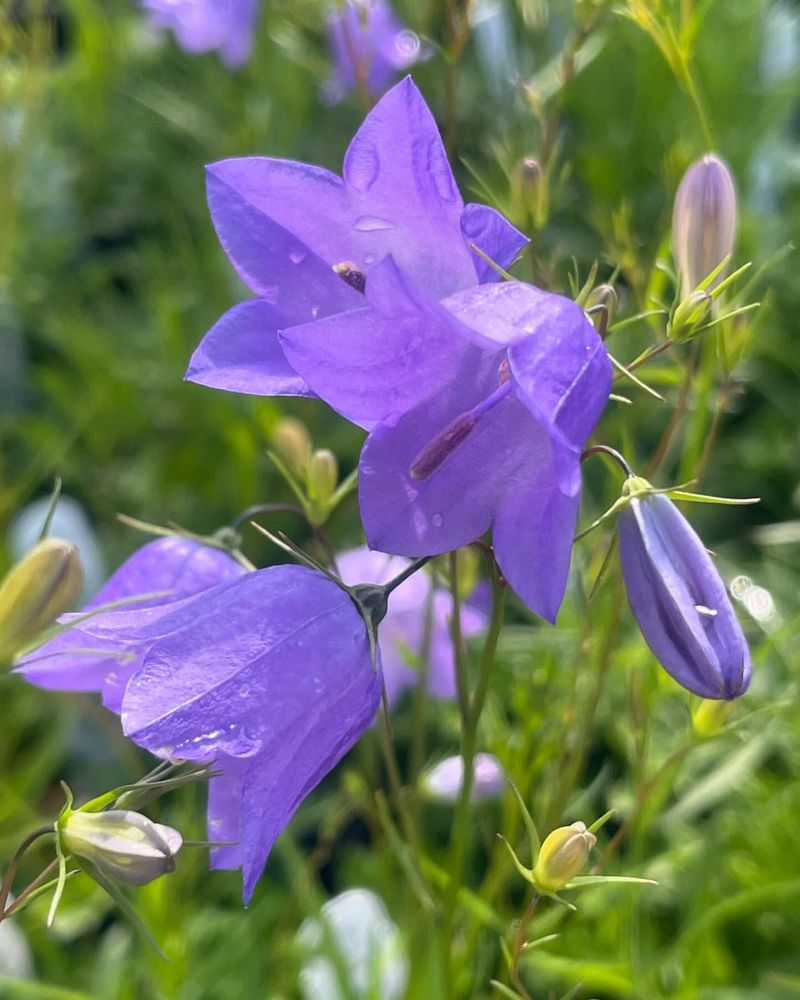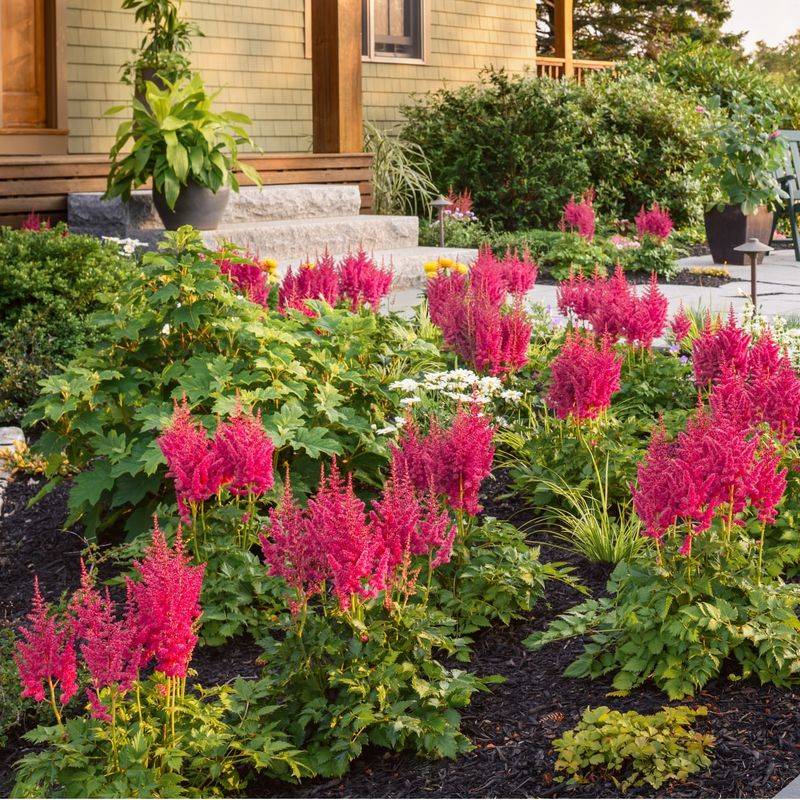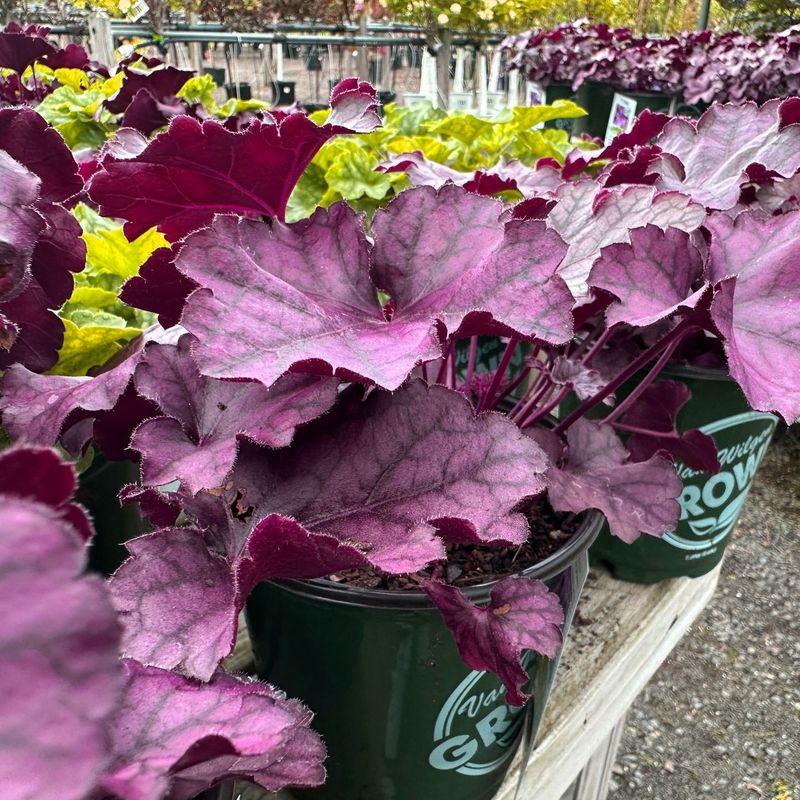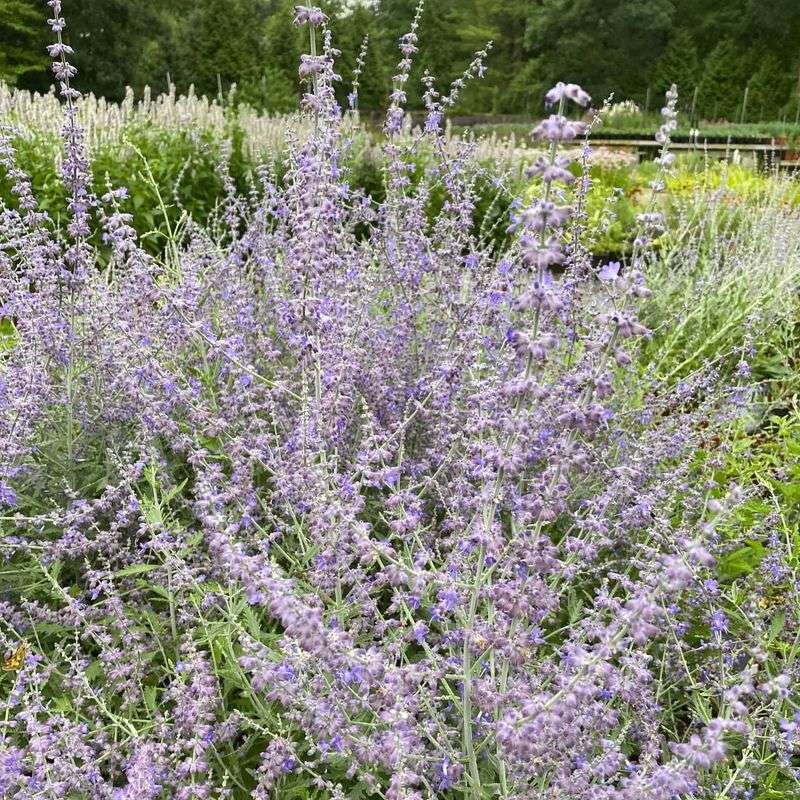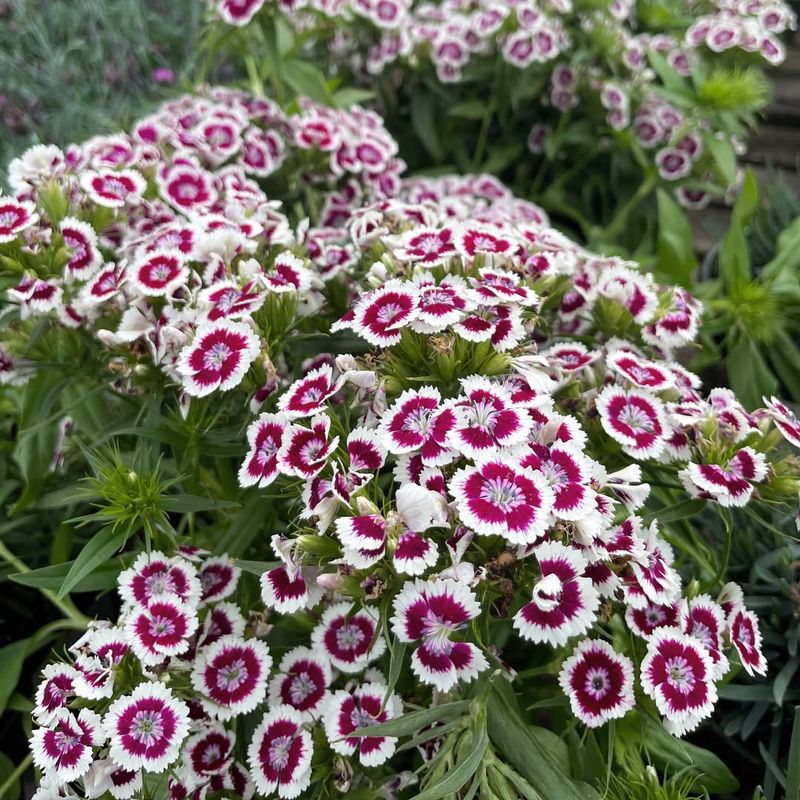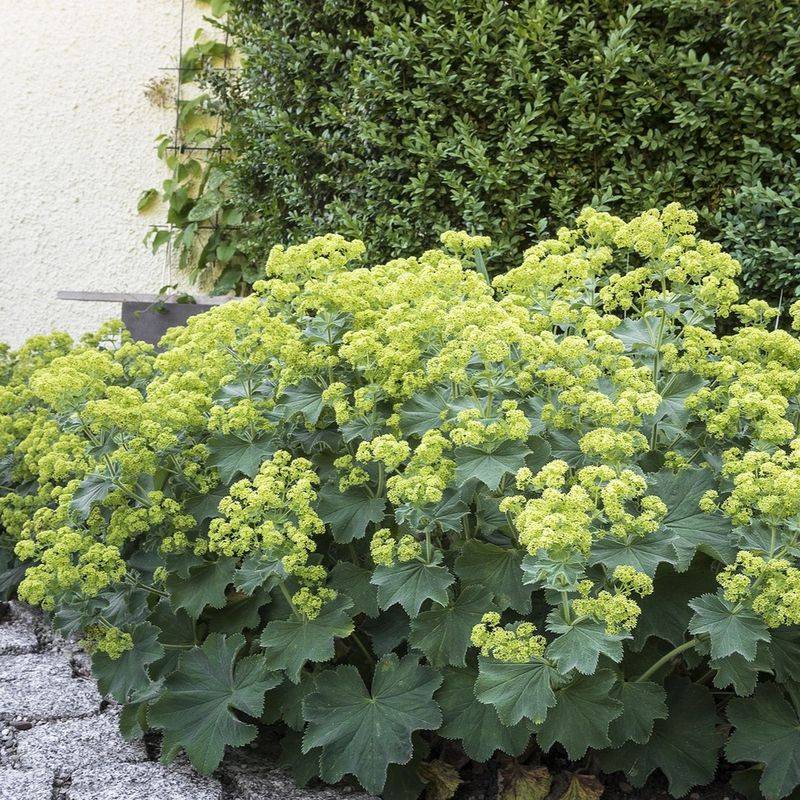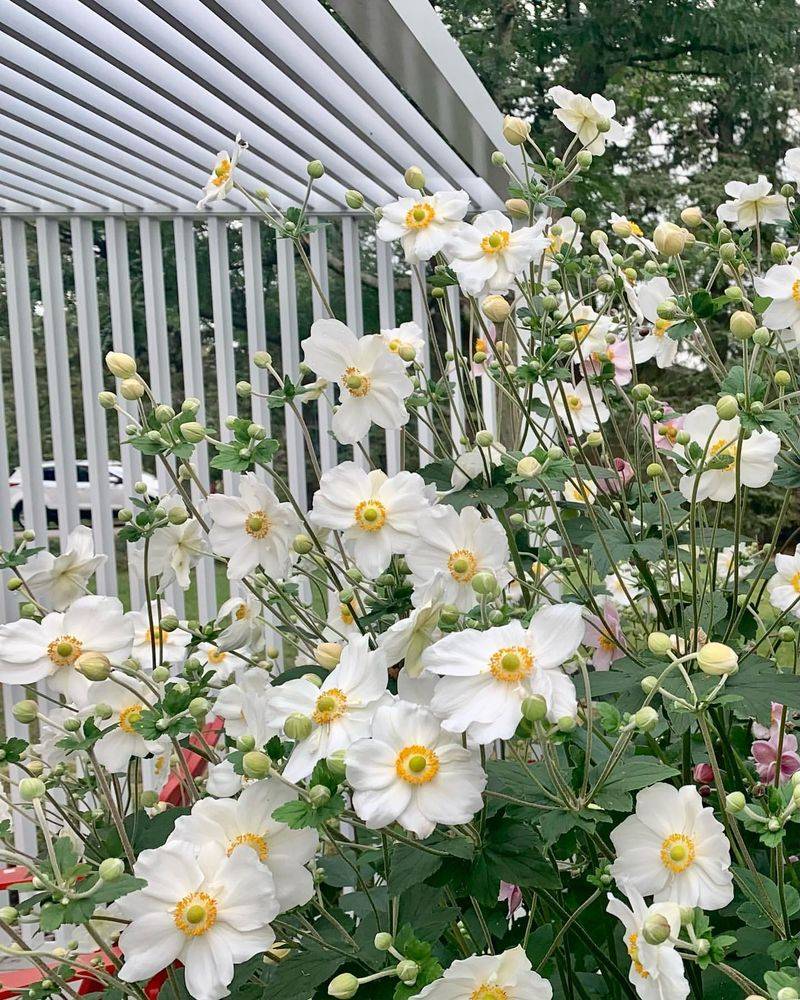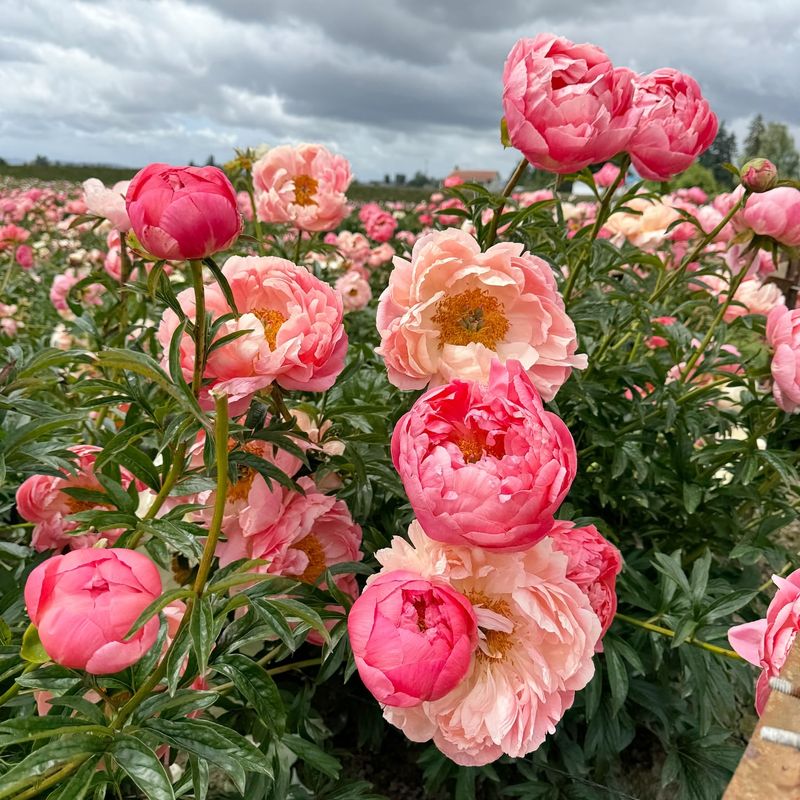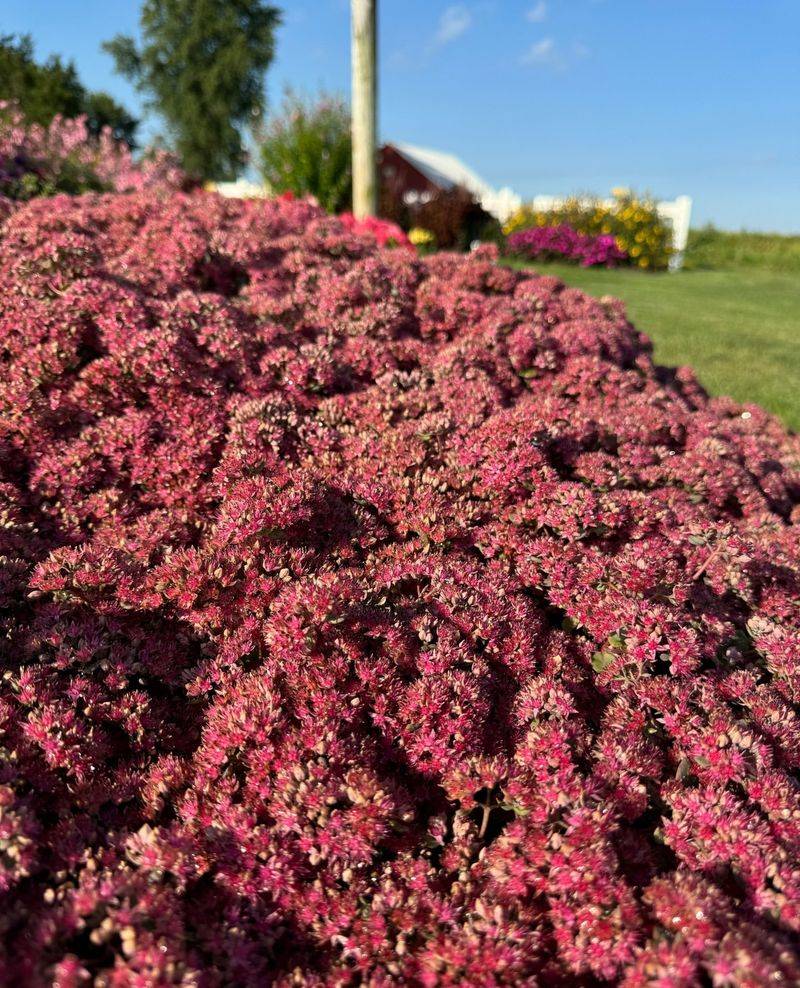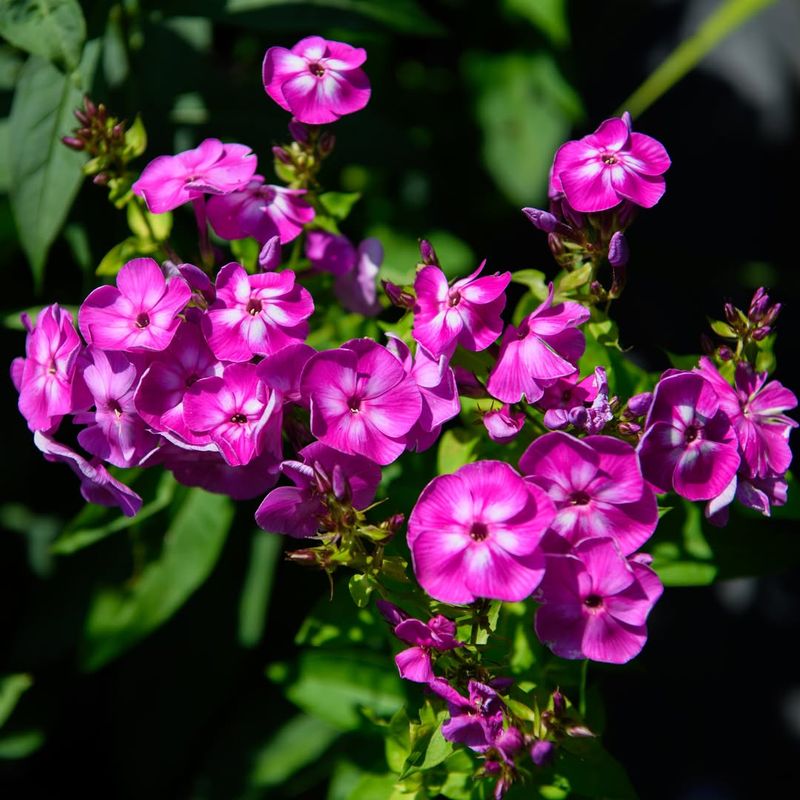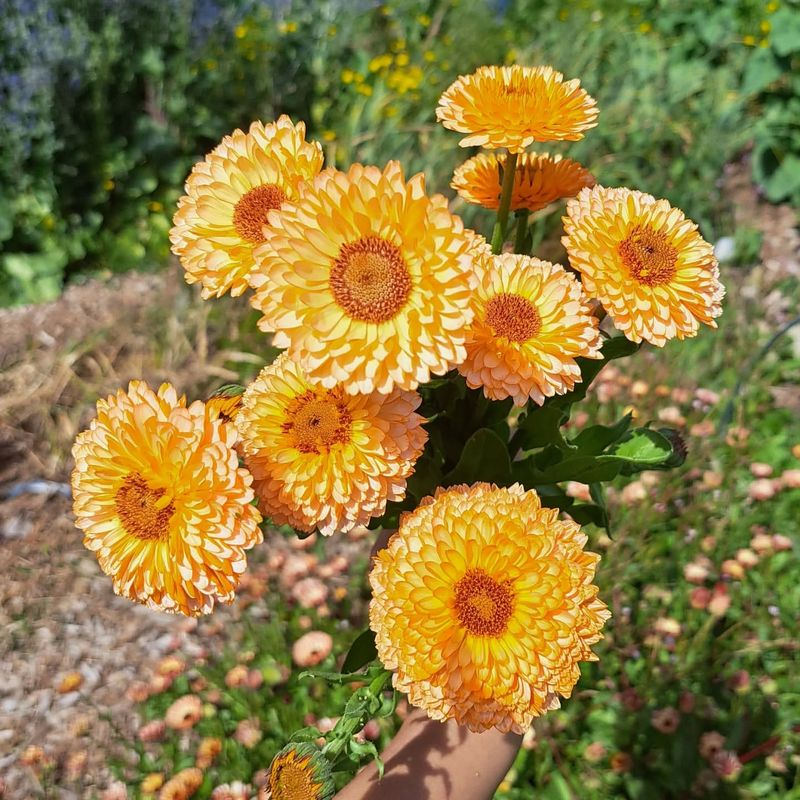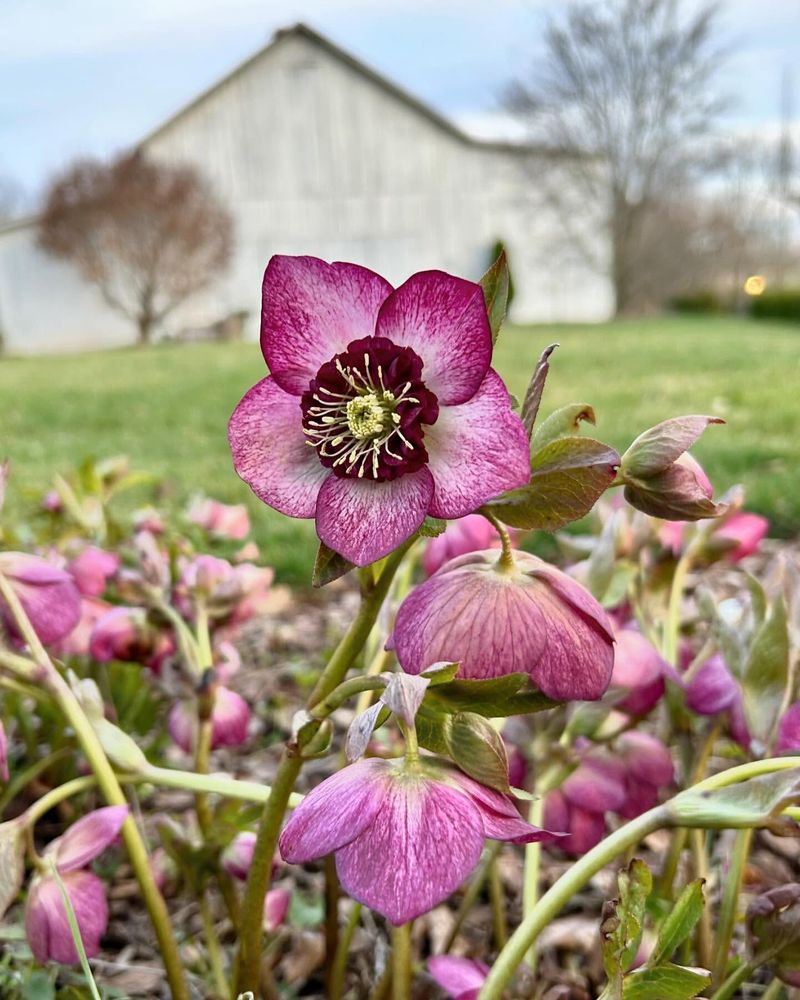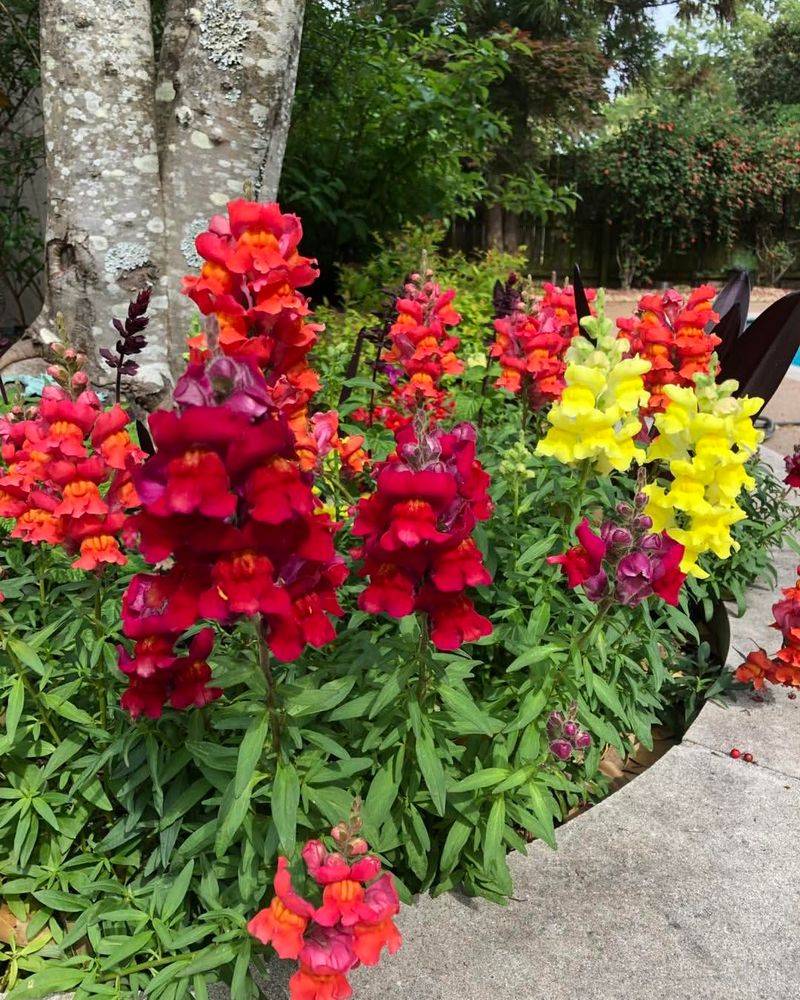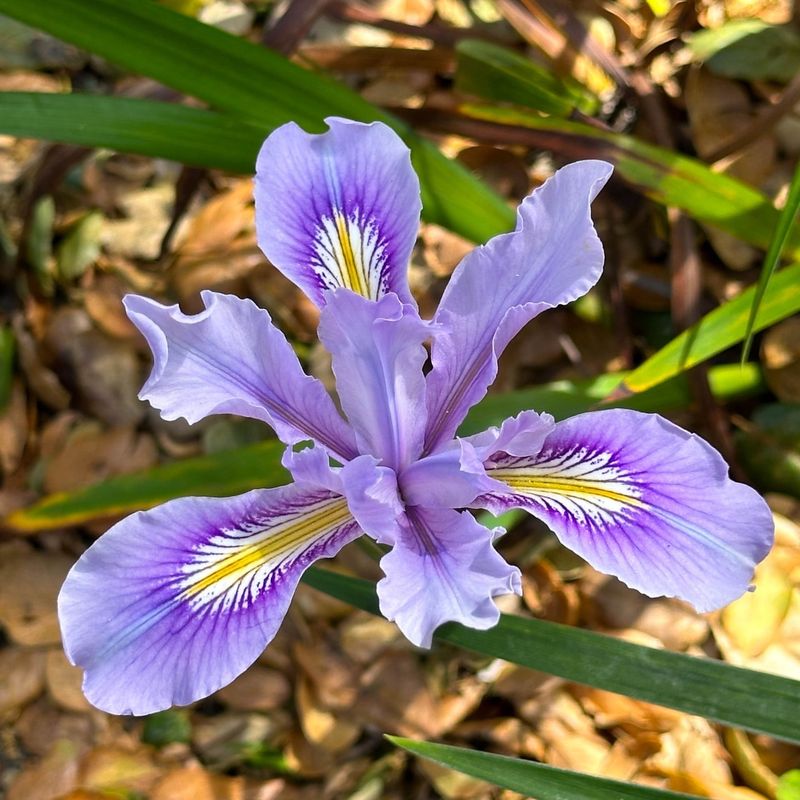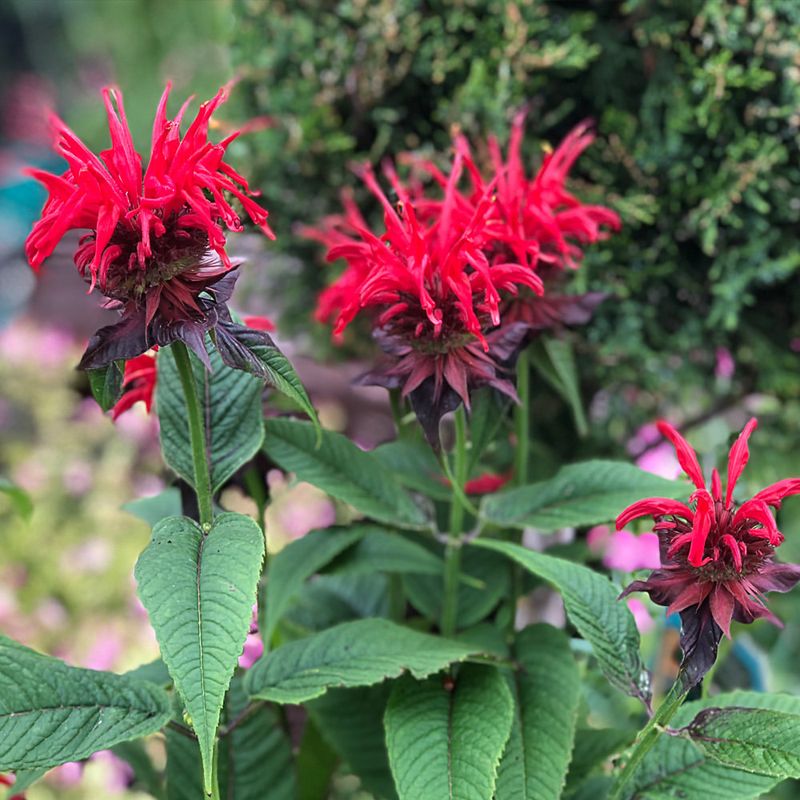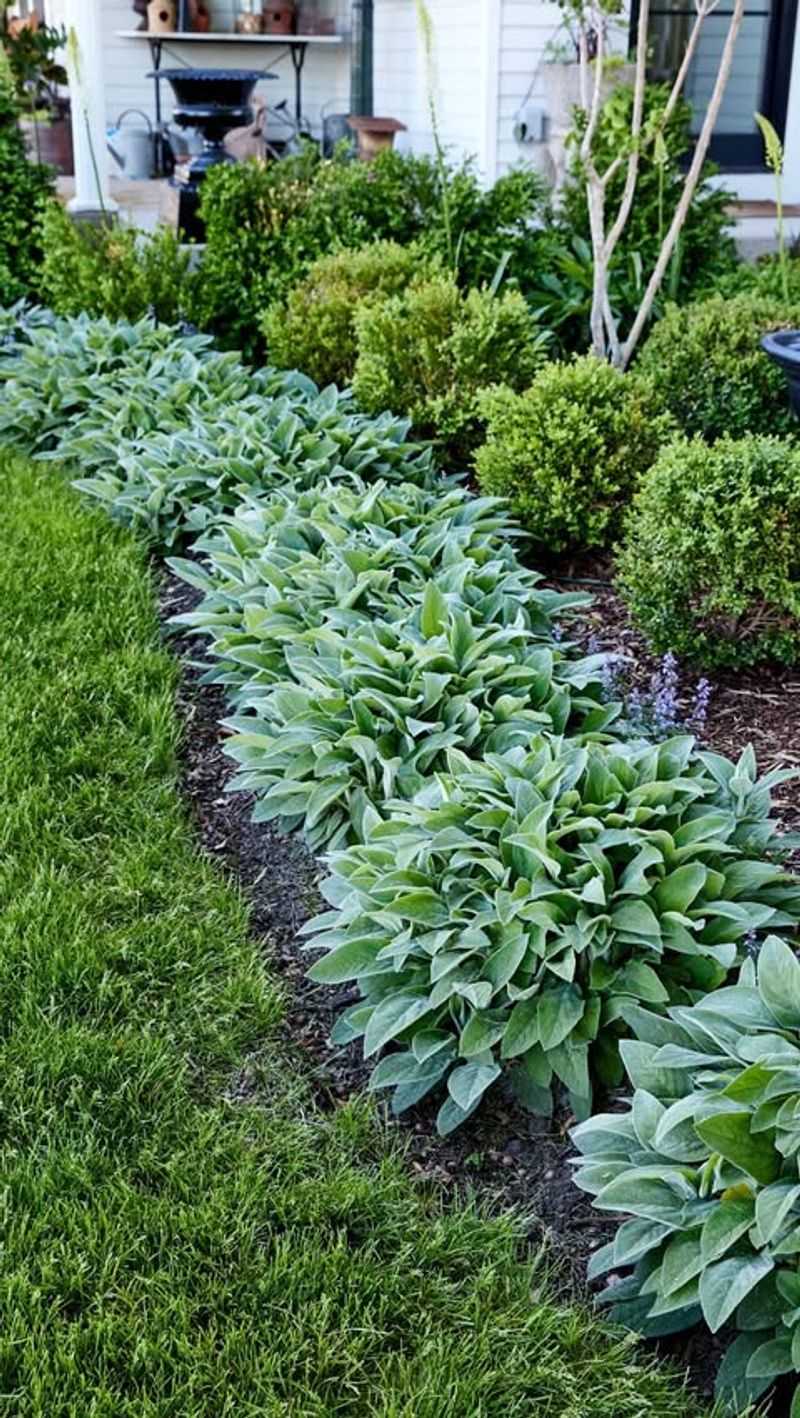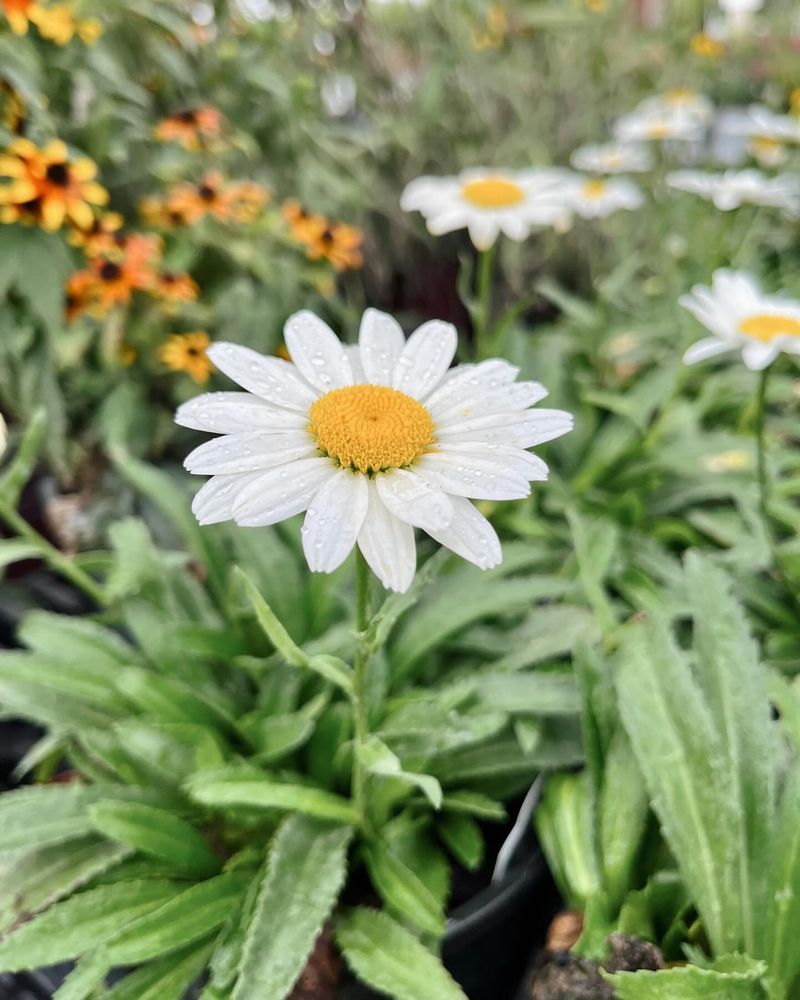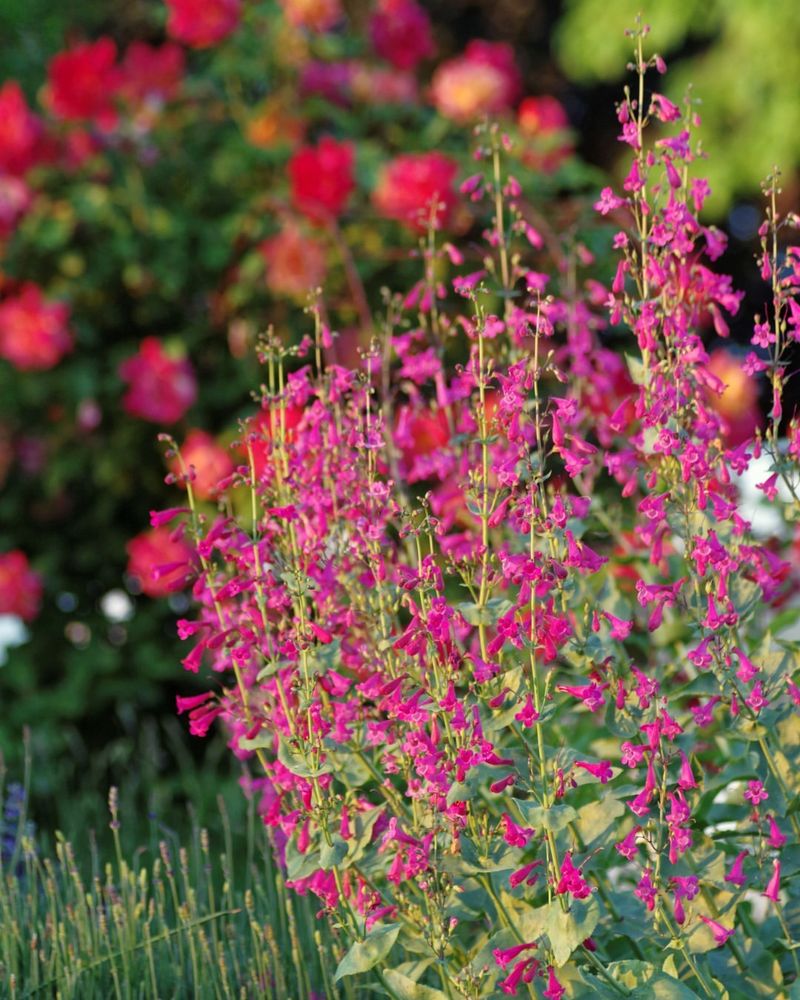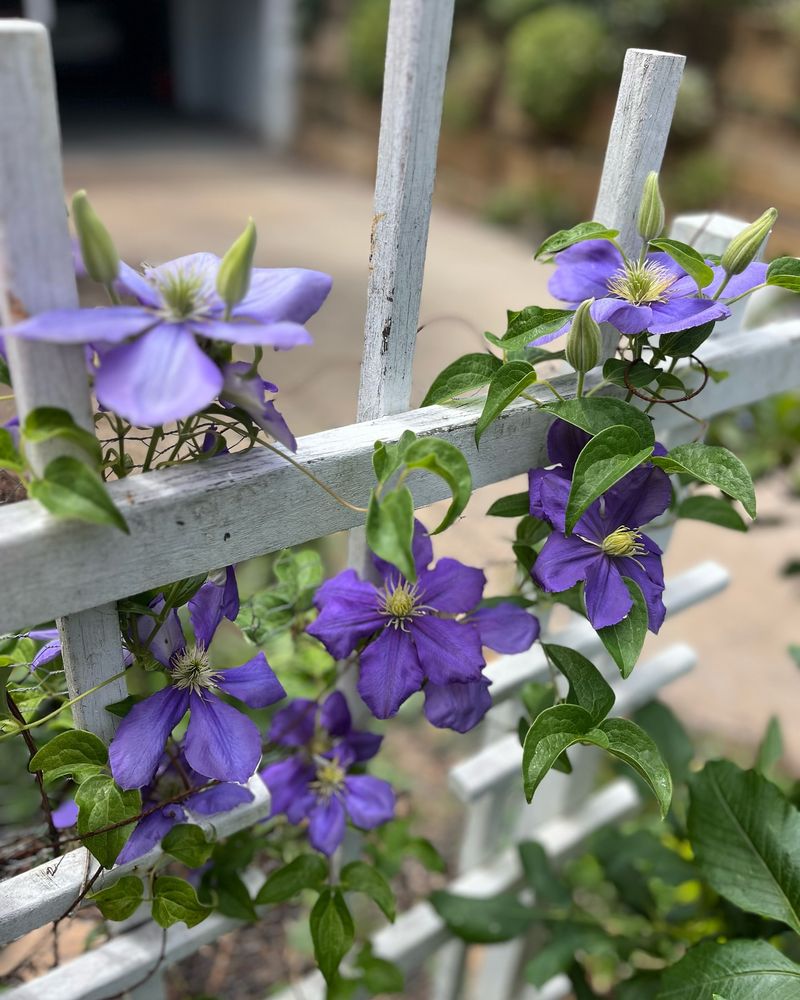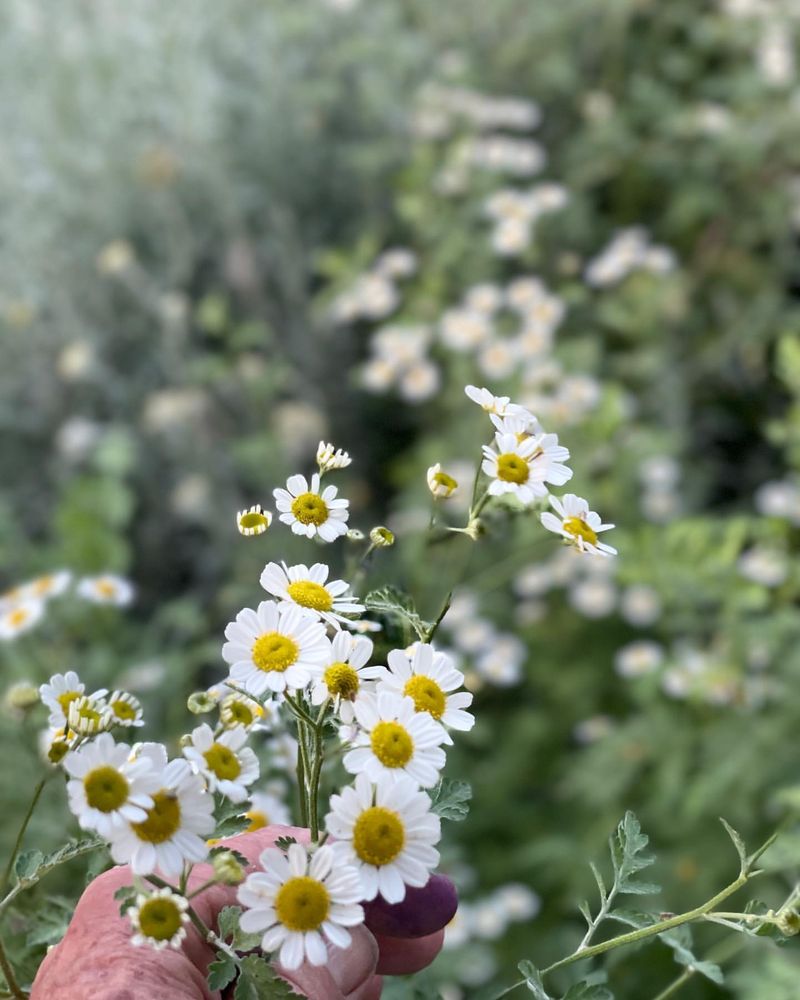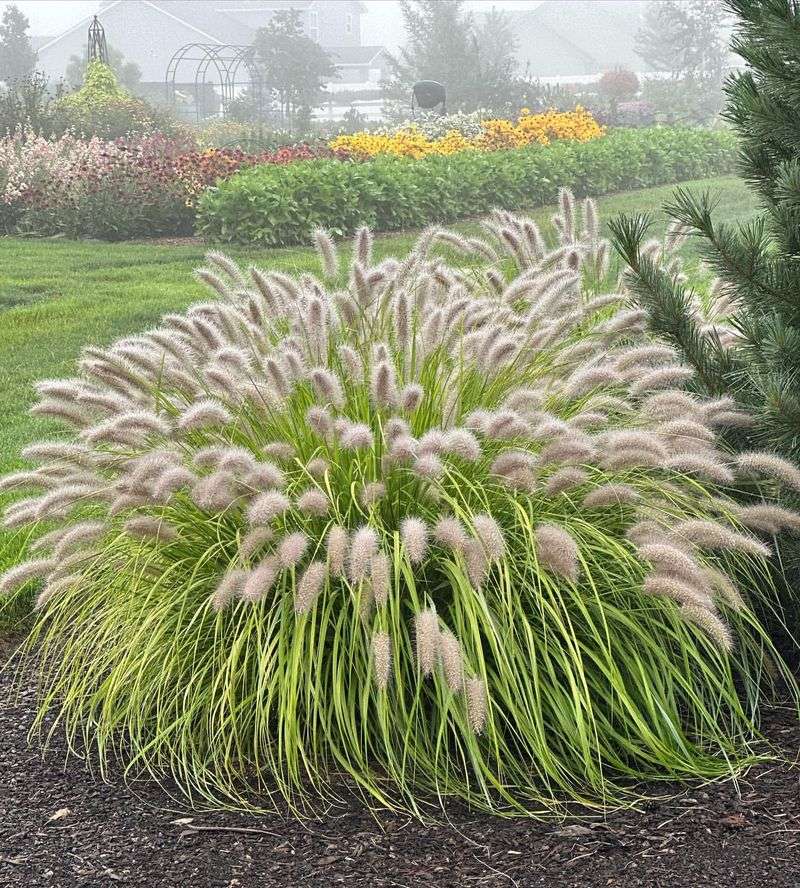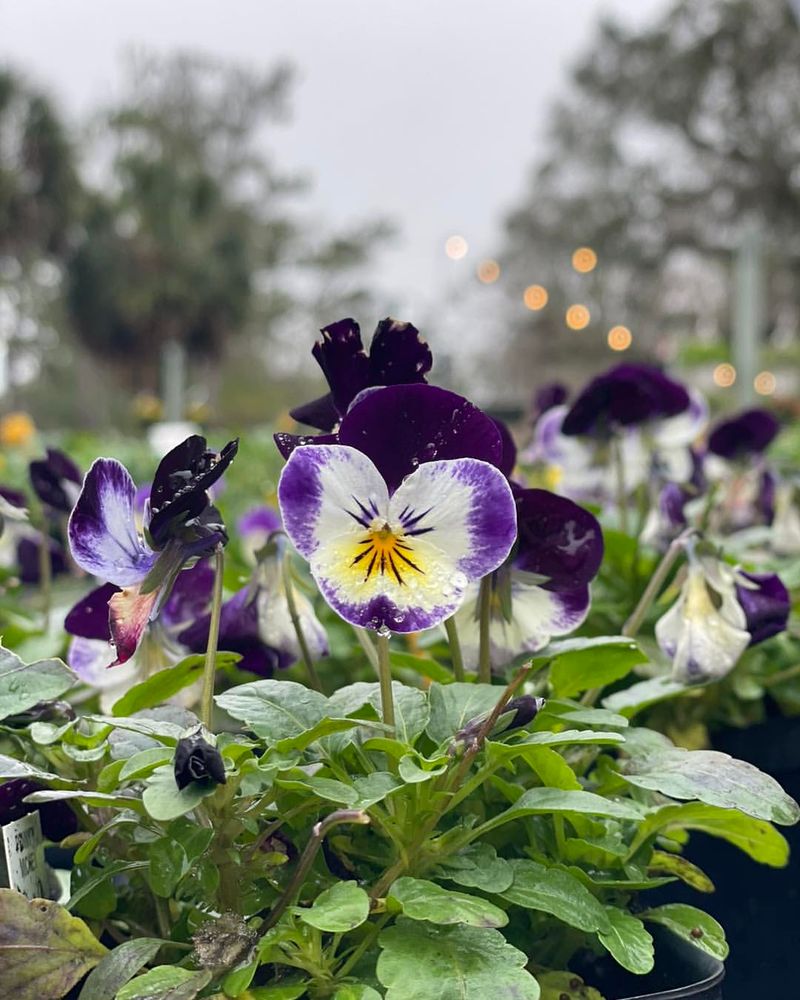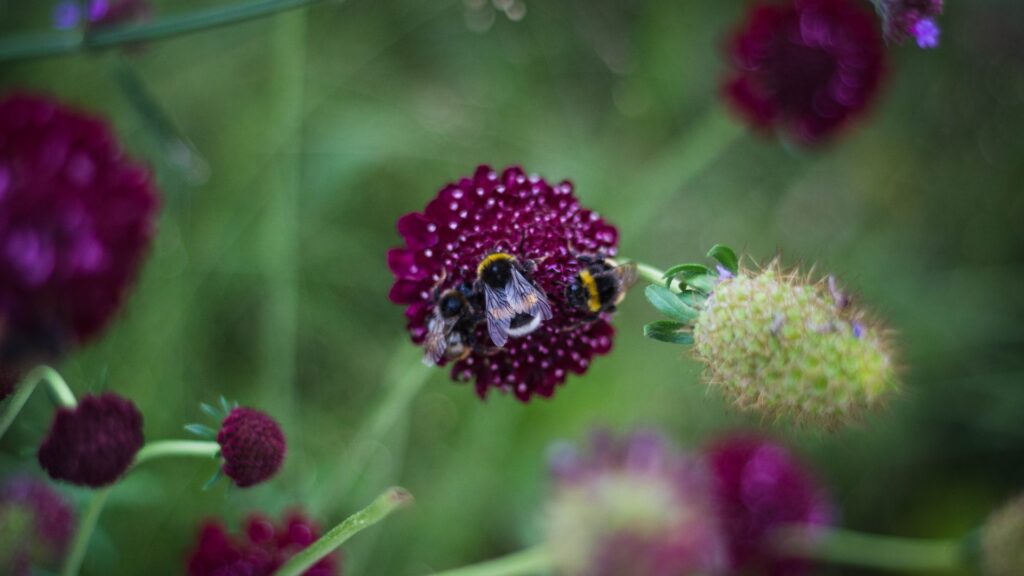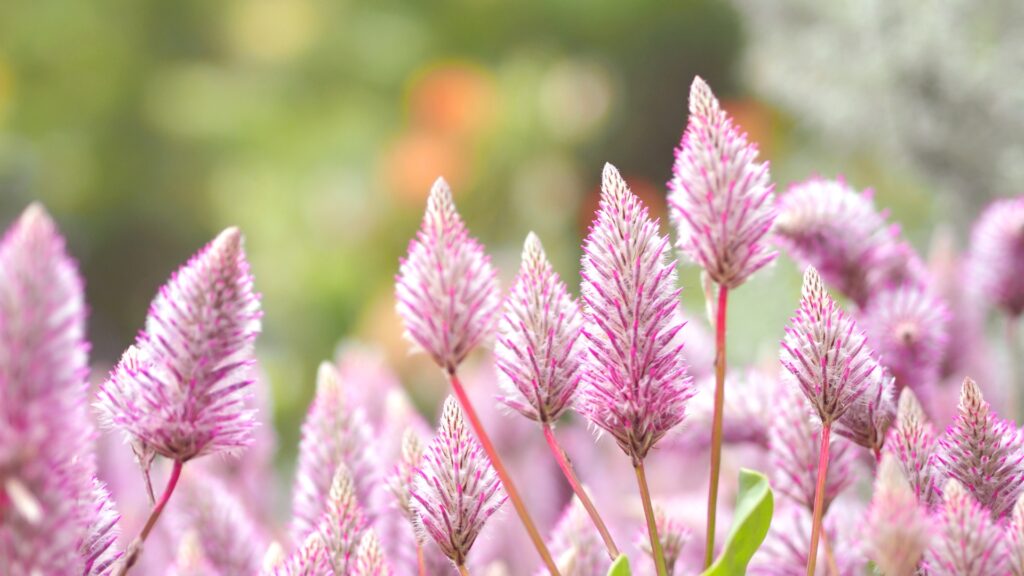Roses are often referred to as the queens of the garden, and rightly so! Their timeless beauty and captivating fragrance make them a favorite among gardeners. However, even queens need a court, and what better way to enhance the allure of your rose garden than with plants that perfectly complement their charm? In this blog post, we’ll explore 35 unique plants that not only highlight the elegance of roses but also bring their own splash of color, texture, and fragrance. Whether you’re aiming for a harmonious blend or a striking contrast, these plants are sure to make your roses stand out even more.
1. Lavender
Lavender, with its soothing fragrance, is the perfect partner for roses. These purple-hued beauties not only add stunning contrast but also attract pollinators. Planting lavender beside roses acts as a natural pest repellent, thanks to its aromatic oils.
Lavender’s low maintenance and drought-tolerant nature make it a gardener’s delight. Imagine a garden where every breath carries the scent of both roses and lavender, a symphony for the senses. The silvery foliage of lavender provides an elegant backdrop to the vivid colors of roses, creating a picturesque scene.
2. Catmint
Catmint is not just for cats—it’s a fantastic companion plant for roses. Its gray-green foliage and delicate purple flowers add a whimsical touch. Catmint blooms for long periods, giving continuous company to your roses. Its sprawling nature fills gaps and creates a lush, carpet-like effect.
As if that weren’t enough, catmint’s minty aroma deters aphids and other pesky bugs from your prized roses. It’s also incredibly easy to care for, thriving in most soil conditions. Catmint and roses together form a charming duo that’s hard to resist.
3. Salvia
Salvia, known for its vibrant spikes of blue flowers, is like the jazz to your rose’s classical melody. It offers a striking contrast that enhances the visual appeal of any garden. Besides its beauty, salvia is a magnet for bees and butterflies, adding life and movement.
These perennials are drought-tolerant and love the sun, just like roses. Planting salvia with roses creates a dynamic duo that is both stunning and hardworking. Their combined fragrance is a delight, making every garden stroll a sensory experience.
4. Foxglove
Foxglove’s towering spires bring an architectural flair to any rose garden. With their tubular blooms, they add height and drama, creating a vertical contrast to the horizontal spread of roses. These biennials are available in shades that complement or contrast with roses, offering versatility.
Foxgloves are loved by hummingbirds, adding another layer of charm to your garden. While they may look delicate, foxgloves are resilient and can thrive in partial shade. Their mysterious allure, combined with the elegance of roses, transforms any garden into a fairytale setting.
5. Geranium
Geraniums, with their vibrant clusters of flowers, are the perfect filler for rose gardens. They bring a burst of color that complements the regal tones of roses. These hardy perennials are known for their long blooming period, ensuring your garden stays lively.
Geraniums also have a dense growth habit, suppressing weeds and reducing garden maintenance. Their lightly scented foliage adds another layer of fragrance to your garden. By combining geraniums and roses, you create a balanced palette that pleases the eye all season long.
6. Yarrow
Yarrow is a resilient plant that pairs beautifully with roses. Its feathery leaves and flat-topped clusters of yellow flowers provide a striking contrast. Yarrow is a haven for beneficial insects, which help keep rose pests in check. It’s drought-resistant and thrives in sunny spots, making it a low-maintenance choice.
The bright, cheerful flowers of yarrow bring a sunny disposition to your rose garden. Together, roses and yarrow form a dynamic duo that is both visually appealing and functional, offering beauty and ecological benefits.
7. Echinacea
Echinacea, also known as coneflower, adds a splash of color to rose gardens. Its daisy-like blooms with prominent centers draw attention and complement the elegance of roses. Echinacea is a perennial that attracts butterflies and bees, promoting pollination.
It’s drought-tolerant and thrives in full sun, just like roses. Planting echinacea with roses not only enhances the garden’s aesthetic appeal but also its ecological balance. This hardy plant adds resilience to your garden, ensuring a vibrant display that lasts through the seasons.
8. Nepeta
Nepeta, also known as catnip, is not just a treat for felines—it’s a delightful companion for roses. Its soft, billowy appearance and lavender-blue flowers add a romantic touch. Nepeta’s long blooming period and drought tolerance make it a practical choice for gardeners.
It acts as a natural pest repellent, keeping aphids at bay. The subtle fragrance of nepeta complements the rich scent of roses, creating an olfactory delight. Together, they form a picture-perfect tableau that enchants both the eyes and the nose.
9. Allium
Allium, with its dramatic spherical blooms, adds a touch of whimsy to rose gardens. These ornamental onions are perfect for adding height and structure. The vibrant purple flowers of allium contrast beautifully with roses, creating a visual feast.
Allium is low maintenance and can deter pests, making it a practical choice. Its architectural presence is not only striking but also functional, providing support and interest. Planting allium with roses ensures a garden that is both aesthetically pleasing and easy to care for.
10. Daylily
Daylilies bring a burst of color and energy to rose gardens. Their trumpet-shaped blooms and arching leaves create a lively contrast. Known for their hardiness and adaptability, daylilies thrive in various conditions. They require minimal care, making them ideal companions for roses.
Daylilies bloom profusely, ensuring a continuous display that complements the beauty of roses. Their bright, cheerful flowers add a playful element, creating a garden that is both joyful and elegant. Together, daylilies and roses form a harmonious blend of color and form.
11. Coreopsis
Coreopsis, with its sunny disposition, adds a cheerful touch to rose gardens. These daisy-like flowers come in vibrant shades that beautifully contrast rose blooms. Coreopsis is a perennial that requires minimal maintenance, thriving in poor soil conditions.
It’s a favorite among pollinators, attracting bees and butterflies. Planting coreopsis with roses creates a lively and dynamic garden. Together, they form a delightful ensemble that is both visually appealing and ecologically beneficial. The combination of coreopsis and roses ensures a garden that is both charming and sustainable.
12. Campanula
Campanula, with its bell-shaped blooms, brings a touch of elegance to rose gardens. These charming flowers come in shades of purple and blue, providing a lovely contrast to roses. Campanula is a perennial that thrives in cooler climates and partial shade.
It’s easy to care for and adds a vertical element to garden beds. The gentle sway of campanula in the breeze adds movement and grace. Combined with roses, campanula creates a garden that is both enchanting and serene. A perfect choice for those seeking tranquility and beauty.
13. Astilbe
Astilbe, known for its feathery plumes, adds texture and color to rose gardens. These perennial beauties come in shades that complement roses, providing a harmonious blend. Astilbe thrives in shady areas, making it a versatile choice for various garden conditions.
Its fern-like foliage adds an extra layer of interest, even when not in bloom. The soft, airy appearance of astilbe contrasts beautifully with the boldness of roses. Planting astilbe with roses creates a garden that is both sophisticated and relaxed, perfect for any landscape.
14. Heuchera
Heuchera, with its vibrant foliage, adds a splash of color to rose gardens. These perennials are available in a range of colors, from deep burgundy to lime green. Heuchera’s unique leaves provide a striking contrast to the lushness of roses. It’s a low-maintenance plant, thriving in both sun and shade.
The delicate flowers of heuchera add an extra layer of beauty, without overshadowing roses. Together, they create a garden that is both colorful and cohesive. A perfect choice for those looking to add variety and interest.
15. Russian Sage
Russian sage, with its airy spikes of lavender-blue flowers, adds a touch of elegance to rose gardens. Its silvery foliage provides a stunning contrast to the rich colors of roses. Russian sage is drought-tolerant and thrives in sunny spots, making it a practical choice.
Its long blooming period ensures a continuous display of color. The gentle sway of Russian sage in the breeze adds movement and grace to the garden. Together with roses, it forms a harmonious and eye-catching duo, perfect for any landscape.
16. Dianthus
Dianthus, with its spicy fragrance and charming flowers, makes a delightful companion for roses. These perennials come in shades of pink and red, complementing rose blooms beautifully. Dianthus’ grey-green foliage adds texture and interest to garden beds.
It’s a low-maintenance plant, thriving in sunny spots and well-drained soil. The compact growth habit of dianthus makes it perfect for edging rose beds. Together, they create a garden that is both fragrant and visually appealing, offering a feast for the senses.
17. Lady’s Mantle
Lady’s mantle, with its soft, green leaves and delicate yellow flowers, adds a touch of charm to rose gardens. Its foliage forms a lush, mounded shape that complements the elegance of roses. Lady’s mantle thrives in shady areas and moist soil, making it a versatile choice. It’s a low-maintenance plant, requiring minimal care.
The subtle beauty of lady’s mantle provides a gentle contrast to the boldness of roses. Planting them together creates a garden that is both calming and delightful, perfect for any setting.
18. Japanese Anemone
Japanese anemone, with its graceful blooms, brings a touch of elegance to rose gardens. These perennials are available in shades of white and pink, providing a soft contrast to roses. Japanese anemone thrives in partial shade and moist soil, making it a versatile choice.
Its long blooming period ensures a continuous display of color. The gentle sway of Japanese anemone in the breeze adds movement and grace. Together with roses, it creates a garden that is both enchanting and serene, perfect for any landscape.
19. Peony
Peonies, with their lush, full blooms, are a perfect complement to roses. These perennials come in shades that beautifully match or contrast with roses. Peonies are known for their longevity and fragrance, adding an extra layer of beauty. They thrive in sunny spots and well-drained soil.
The soft, romantic appearance of peonies contrasts beautifully with the structured elegance of roses. Planting them together creates a garden that is both sophisticated and charming, offering a feast for the senses.
20. Sedum
Sedum, with its succulent leaves and vibrant flowers, adds texture and interest to rose gardens. These perennials are available in shades of pink and green, providing a striking contrast. Sedum thrives in sunny spots and poor soil, making it a low-maintenance choice.
It’s drought-tolerant, ensuring a resilient and long-lasting display. The unique appearance of sedum adds a modern touch to the classic beauty of roses. Together, they create a garden that is both stylish and sustainable, perfect for any landscape.
21. Phlox
Phlox, with its vibrant clusters of flowers, adds a burst of color to rose gardens. These perennials come in shades of pink and purple, providing a lovely contrast. Phlox is known for its long blooming period and sweet fragrance. It thrives in sunny spots and well-drained soil, making it a practical choice.
The compact growth habit of phlox makes it perfect for filling gaps in rose beds. Together, they create a garden that is both lively and fragrant, offering a feast for the senses.
22. Calendula
Calendula, often known as pot marigold, is famed for its striking orange and yellow flowers. These blooms are more than just decorative; they can repel pests such as whiteflies and aphids, which can damage rose plants.
This plant is easy to grow and thrives in sunny spots with well-drained soil. Regular deadheading of flowers encourages continuous blooming, ensuring a vibrant display throughout the growing season.
In addition to its pest-repelling properties, calendula can be used in homemade skincare remedies, adding a multifunctional aspect to your rose garden. Its cheerful blooms complement the elegance of roses beautifully.
23. Hellebore
Hellebore, with its elegant blooms, brings a touch of sophistication to rose gardens. These perennials come in shades of white and purple, providing a striking contrast. Hellebore thrives in shady areas and well-drained soil, making it a versatile choice.
Its early blooming period ensures a continuous display of color. The graceful appearance of hellebore adds a touch of romance to the structured elegance of roses. Together, they create a garden that is both enchanting and serene, perfect for any landscape.
24. Snapdragon
Snapdragons, with their vibrant spikes of flowers, add a playful touch to rose gardens. These annuals come in shades of red and orange, providing a bold contrast. Snapdragons are known for their long blooming period and sweet fragrance.
They thrive in sunny spots and well-drained soil, making them a practical choice. The unique shape of snapdragon flowers adds a whimsical element to garden beds. Together with roses, they create a garden that is both lively and charming, offering a feast for the senses.
25. Iris
Irises, with their elegant blooms, bring a touch of sophistication to rose gardens. These perennials come in shades of purple and blue, providing a striking contrast. Irises are known for their tall, stately appearance and sweet fragrance.
They thrive in sunny spots and well-drained soil, making them a practical choice. The graceful appearance of irises adds a touch of romance to the structured elegance of roses. Together, they create a garden that is both enchanting and serene, perfect for any landscape.
26. Bee Balm
Bee balm, with its vibrant clusters of flowers, adds a burst of color to rose gardens. These perennials come in shades of red and pink, providing a lovely contrast. Bee balm is known for its long blooming period and sweet fragrance. It thrives in sunny spots and well-drained soil, making it a practical choice.
The compact growth habit of bee balm makes it perfect for filling gaps in rose beds. Together, they create a garden that is both lively and fragrant, offering a feast for the senses.
27. Lamb’s Ear
Lamb’s ear, with its soft, silver leaves, adds a touch of elegance to rose gardens. Its foliage forms a lush, mounded shape that complements the elegance of roses. Lamb’s ear thrives in sunny spots and well-drained soil, making it a versatile choice. It’s a low-maintenance plant, requiring minimal care.
The subtle beauty of lamb’s ear provides a gentle contrast to the boldness of roses. Planting them together creates a garden that is both calming and delightful, perfect for any setting.
28. Shasta Daisy
Shasta daisies, with their classic white petals and yellow centers, bring a touch of freshness to rose gardens. These perennials are known for their long blooming period and cheerful appearance. Shasta daisies thrive in sunny spots and well-drained soil, making them a practical choice.
Their simple beauty provides a lovely contrast to the elegance of roses. Together, they create a garden that is both lively and charming, offering a feast for the senses. A perfect choice for those looking to add a touch of classic beauty.
29. Penstemon
Penstemon, with its vibrant spikes of flowers, adds a touch of elegance to rose gardens. These perennials come in shades of pink and red, providing a striking contrast. Penstemon is known for its long blooming period and sweet fragrance. It thrives in sunny spots and well-drained soil, making it a practical choice.
The unique shape of penstemon flowers adds a whimsical element to garden beds. Together with roses, they create a garden that is both lively and charming, offering a feast for the senses.
30. Clematis
Clematis, with its elegant vines and vibrant flowers, adds a touch of romance to rose gardens. These climbers come in shades of purple, providing a striking contrast. Clematis is known for its long blooming period and sweet fragrance. It thrives in sunny spots and well-drained soil, making it a practical choice.
The graceful appearance of clematis adds a touch of romance to the structured elegance of roses. Together, they create a garden that is both enchanting and serene, perfect for any landscape.
31. Feverfew
Feverfew, with its small, daisy-like flowers, brings a touch of charm to rose gardens. These perennials are known for their long blooming period and cheerful appearance. Feverfew thrives in sunny spots and well-drained soil, making it a practical choice.
Its simple beauty provides a lovely contrast to the elegance of roses. Together, they create a garden that is both lively and charming, offering a feast for the senses. A perfect choice for those looking to add a touch of classic beauty.
32. Ornamental Grasses
Ornamental grasses, with their elegant plumes, add a touch of movement to rose gardens. These perennials are known for their low-maintenance nature and graceful appearance. Ornamental grasses thrive in sunny spots and well-drained soil, making them a practical choice.
Their simple beauty provides a lovely contrast to the elegance of roses. Together, they create a garden that is both lively and charming, offering a feast for the senses. A perfect choice for those looking to add a touch of classic beauty.
33. Violas
Violas, with their delicate blooms, bring a touch of charm to rose gardens. These perennials come in shades of purple and yellow, providing a striking contrast. Violas are known for their long blooming period and sweet fragrance.
They thrive in sunny spots and well-drained soil, making them a practical choice. The compact growth habit of violas makes it perfect for filling gaps in rose beds. Together, they create a garden that is both lively and fragrant, offering a feast for the senses. A perfect choice for those looking to add a touch of classic beauty.
34. Scabiosa
Scabiosa, often called pincushion flower, adds a delicate elegance to rose gardens. With its soft, domed blooms and slender stems, it provides a light and airy contrast to the full-bodied richness of roses. Available in shades of lavender, pink, and white, scabiosa blends beautifully into any rose color scheme.
These long-blooming perennials are loved by pollinators, bringing butterflies and bees to your garden. Scabiosa thrives in sunny spots with well-drained soil, making it a reliable and low-maintenance companion. Together with roses, it creates a garden that is both graceful and full of life.
35. Tiarella
Tiarella, also known as foamflower, brings a woodland charm to rose gardens. Its frothy, star-shaped blooms rise above deeply lobed, often patterned foliage, adding layers of texture and visual interest. Tiarella’s soft white or pale pink flowers offer a gentle complement to the boldness of roses.
Thriving in partial shade and moist, rich soil, tiarella is perfect for softening the edges of rose beds or filling in shadier spots. Its subtle beauty and compact growth habit make it an ideal choice for adding depth and variety. Combined with roses, tiarella creates a serene and sophisticated garden palette.

